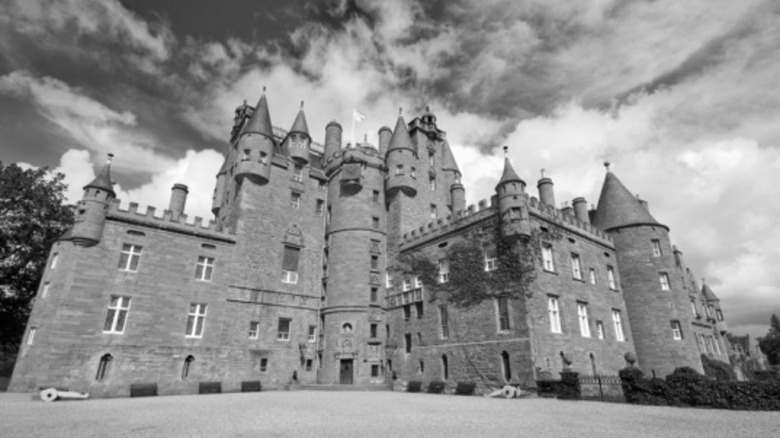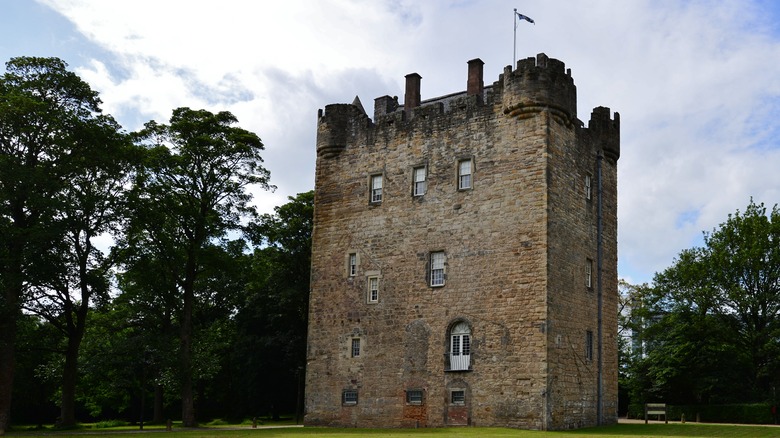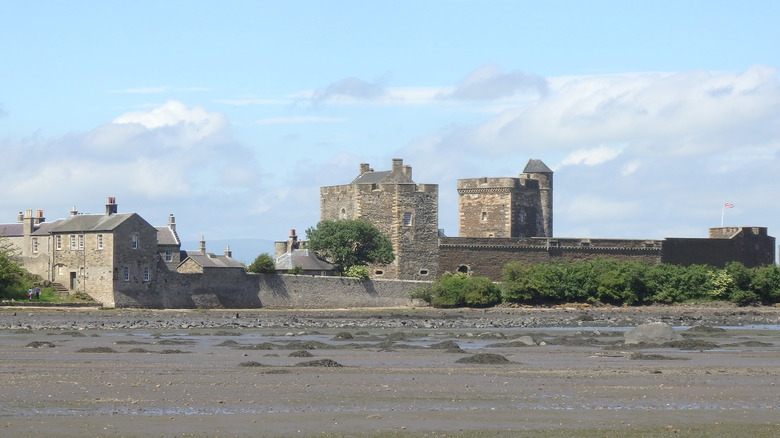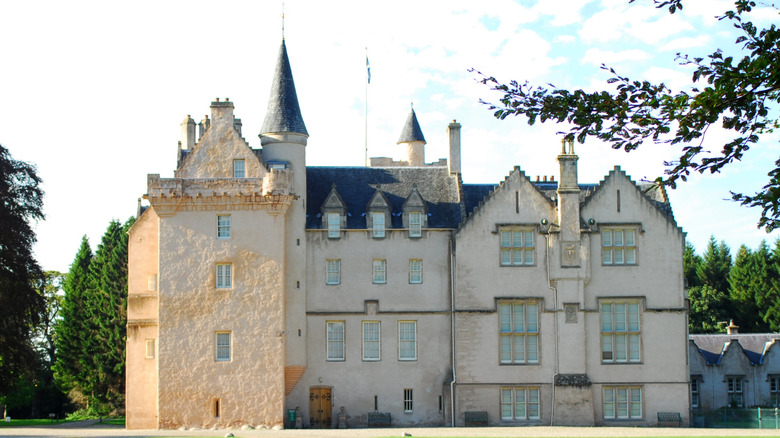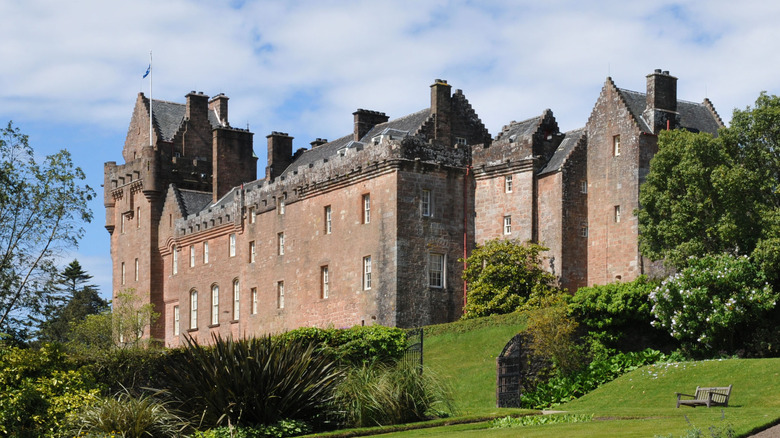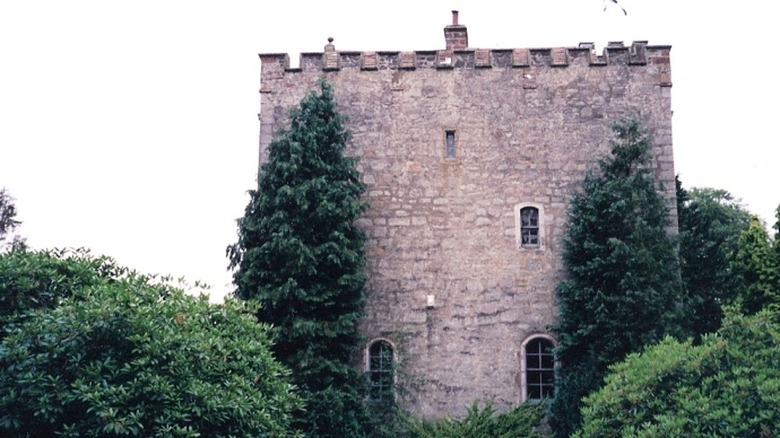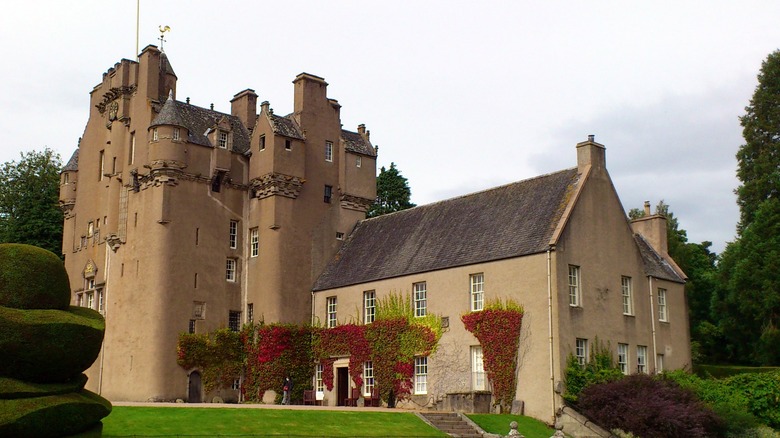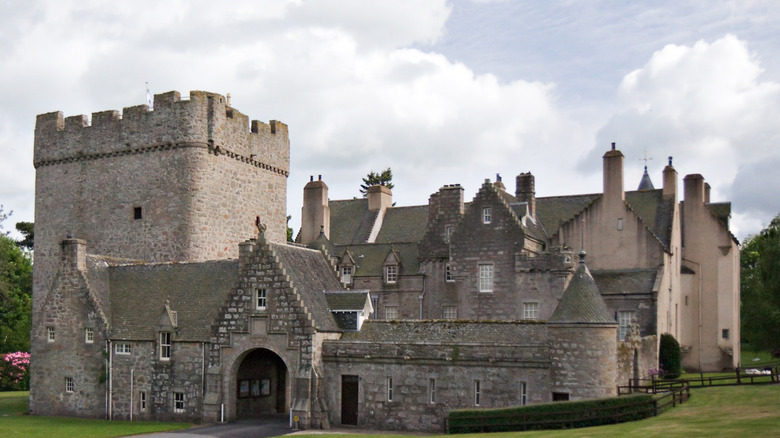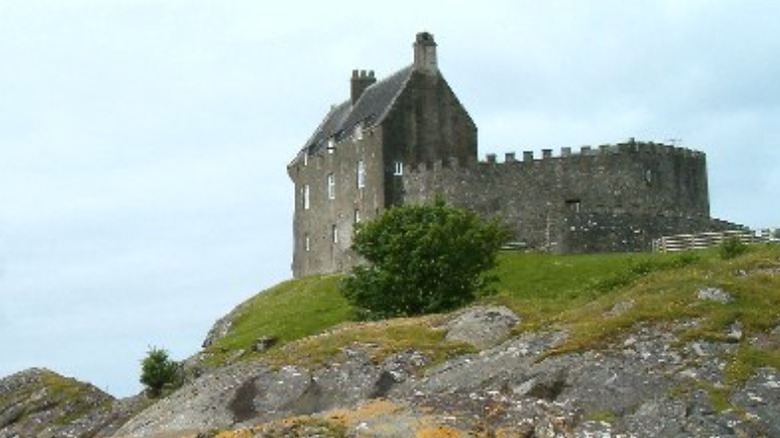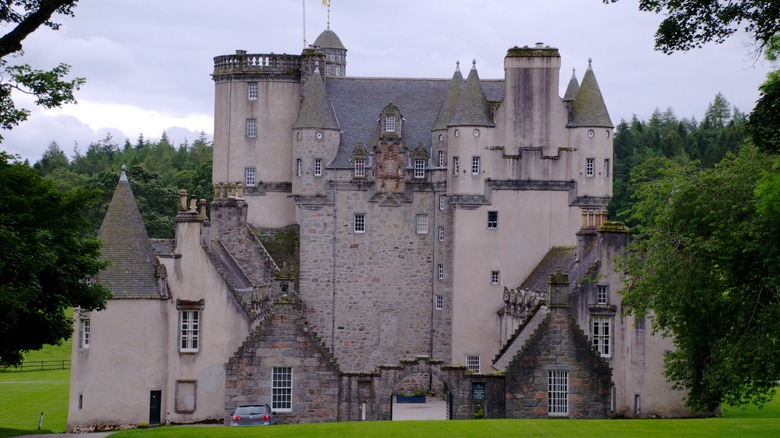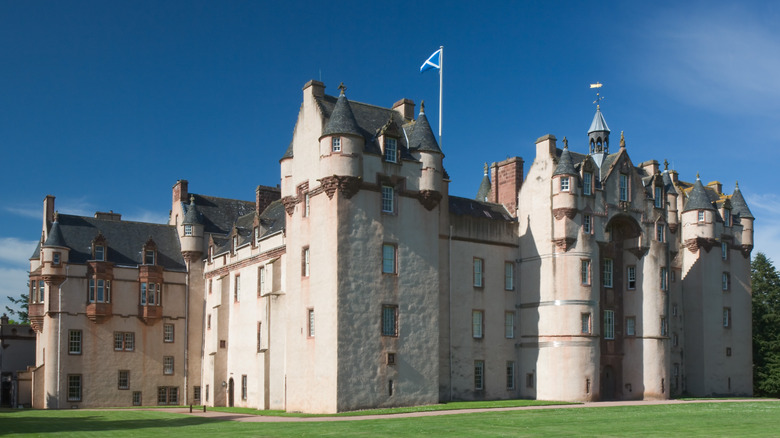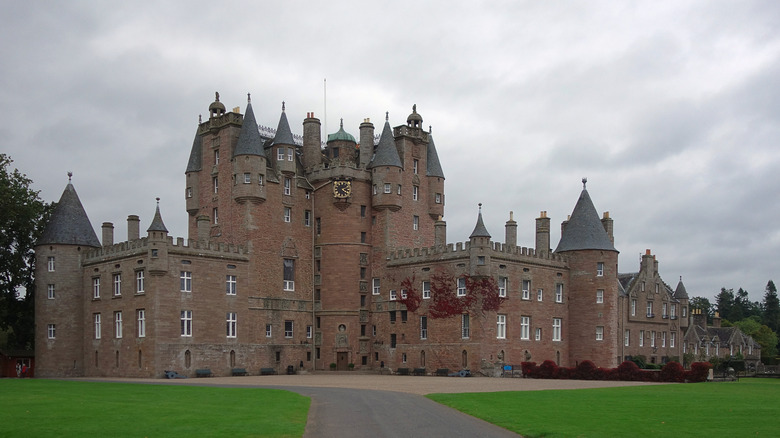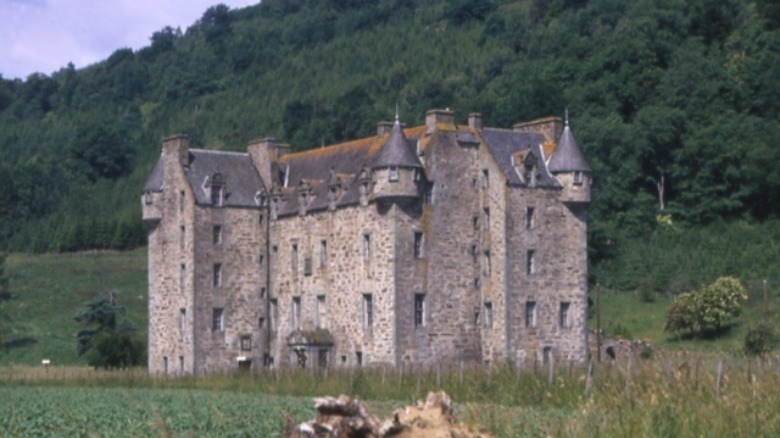The Castles Of Scotland Are Home To Some Supernatural Beings
If you think about it, castles are pretty ideal places for hauntings. They're usually pretty old, sometimes crumbling, frequently dark, possibly musty, and if they're still furnished, they're probably full of, like, suits of armor and creepy paintings and so forth. Plus, they might have dungeons, secret chambers, torture racks, and literal skeletons in literal closets. Why wouldn't a ghost want to hang out there? And with some ancestral families inhabiting them for centuries, there are all sorts of dead people who would be available to hang out there. That's just math.
David Weinczok, an expert on Scottish castles, told The Scotsman he estimates the country has around 2,000, even if most of those are ruins today. There are plenty of old tower houses still standing, however, and basically all of them claim to be home to ghosts, witches, phantom animals, and all sorts of spooky manifestations. Here are just a few of Scotland's spookiest castles.
Alloa Tower's hanged man
According to the National Trust for Scotland, Alloa Tower is the oldest and largest surviving castle keep in all of Scotland, having been built in the 1300s, where its job was to protect the nearby ferry over the River Forth. The tower was significantly updated in the 1700s by John Erskine, the sixth Earl of Mar, whose family line was the stewards of the tower for generations. The Erskines were staunch supporters of the monarchs of the Stuart line, with both Mary, Queen of Scots, and James VI (the Bible one) having been brought up under the guardianship of Erskines. John Erskine himself was the leader of the 1715 uprising of the Jacobites, supporters of the exiled Stuart king James II.
As far back as 1907, a book on the haunted houses of Britain recorded that Alloa was famously cursed. The grounds are also said to be full to the brim with ghosts. Famous specters found on the grounds include a ghostly man chained up in the dungeon whose chewed-up foot is constantly tended to by the spirit of a serving girl; a young girl trapped in a well within the Great Hall; and a hanged man in the Solar Room whose presence makes visitors feel as if they are being strangled. Likewise, on the anniversary of Alloa's adjoining mansion burning down in 1800, visitors to the tower claim they can smell smoke and the aroma of burning.
Blackness Castle's phantom knight
Blackness Castle in West Lothian on the shores of the Firth of Forth was built in the 15th century, and in the following years served as a stronghold, a prison, an artillery fortification, a royal castle, and a movie set. Its imposing stone facade and somewhat pointed shape have led to it being called "the ship that never sailed." It has served as a filming location for the 2018 films "Mary, Queen of Scots" and "The Outlaw King" as well as several scenes in the TV series "Outlander."
As author Alan C. Wood explains in "Military Ghosts," the castle's name is a fitting one, as a veil of darkness seems to hang over the place. In addition to there being a general aura of evil surrounding the dark stone walls and its central Prison Tower, visitors to the castle have reported experiencing strange noises as if furniture were being dragged or thrown around in adjacent rooms. When these sounds were investigated, no source could be found, but the noises began again as soon as the rooms were empty. Perhaps the most famous ghostly manifestation, however, came in the late 1990s when a woman was visiting the castle with her sons and came face to face with a ghost dressed in a full suit of armor who angrily chased her from the Prison Tower, sword in hand.
Brodie Castle's haunted study
Brodie Castle in Moray, Scotland, has been in possession of the Brodie clan since the 1500s, though the lands have belonged to them since the 1100s. The long history of the castle can be seen in the various historical architectural styles applied throughout the different wings of the building, with looks ranging from medieval to Victorian. The castle is also famous for its large collection of artwork, books, and furniture, and the sprawling and colorful Playful Garden that surrounds the castle with over 100 kinds of daffodils.
Despite this cheerful exterior, however, the castle is home to a number of ghosts, including a ghostly soldier that can be found in one of the sitting rooms; the ghost of Lady Margaret Brodie, who died in a fire in the castle in 1786; and a small spectral dog that can be seen running toward the nursery. The website Medieval Castle records one of the most famous spooky tales of the castle, in which the 19th century Earl of Brodie was traveling in Switzerland, but the household staff could hear rustling and moaning sounds inside his locked study. The next day it was discovered that the Earl had died in Switzerland the night before, but apparently his ghost had some unfinished work in his study at home.
Brodick Castle's white stag
Despite its hilarious name, Brodick Castle was an important defensive site on the Isle of Arran in the Firth of Clyde for centuries. According to Undiscovered Scotland, the site was likely first used as a fortification by the Vikings before the castle was built there in the 13th century, developed through to the 17th century, and then hugely expanded and renovated in the 19th century. During that time, the castle passed hands between the English, the Scots, and Oliver Cromwell's Parliamentary army, but today belongs to the National Trust of Scotland and is open to the public.
The grounds of the castle include a number of spooky spots, including a hidden room that was rediscovered in 1977 that is believed to have been the castle's dungeon, and the Bavarian Summer house, an outbuilding in the surrounding park that looks like something out of a dark fairy tale. But the real supernatural phenomena come in the form of the castle's three famous ghosts: a man who appears sitting in the library; the Grey Lady, said to be the ghost of one of three plague victims who starved to death in the dungeon; and the White Stag, a spectral deer that they say only appears on the grounds of the castle when the head of the Hamilton family — the traditional owners of the castle –- is about to die.
Closeburn Castle's bloody swan
The official website of Closeburn Castle in Dumfries says that it is the oldest still-inhabited tower house in Scotland, with a history reaching back to 1232, when the Kirkpatrick family was granted the land by Scottish king Alexander II. The tower was used purely defensively until 1748, when the Kirkpatricks moved into the tower after their nearby mansion was burned down. Although the castle was heavily renovated to become a suitable family home, many elements of the original fortress remain even to this day, including the iron gate, great hall, and dungeons.
the castle is known to have some of the more standard ghostly phenomena that you might expect in an old ancestral home like that, such as a phantom lady wearing black and dogs barking at unseen presences for hours. Perhaps the most interesting story, however, surrounds a death omen particular to the Kirkpatrick family. According to legend, years ago, Robert Kirkpatrick used a crossbow to shoot a swan that was swimming on the loch surrounding the castle. Castles and Manor Houses around the World explains that ever since, a swan with a bloody breast has appeared swimming on the loch just before death or disaster befalls a member of the Kirkpatrick household. Multiple ghost tours are available to the public at Closeburn, but presumably, they're hoping people will see the Lady in Black and not the Bleeding Swan.
Crathes Castle's Green and White Ladies
If you read enough about haunted places, you'll realize that lots of them have ghosts of women who are simply known as "the [color] Lady," and you'll see a fair few of them on this list. Crathes Castle in Aberdeenshire gives you a nice opportunity for a twofer, as it features both a White Lady and a Green Lady. As Hidden Scotland explains, Crathes Castle traces its origins back to land given to the Burnett family by Robert the Bruce (like from "Braveheart") back in 1323. The family built the castle tower on that land in 1596 and held possession of it until they passed it to the National Trust in 1951, who maintains it to this day.
Of the two lady ghosts, the White Lady is less well-known, but she is said to be the ghost of a bride-to-be of a young Burnett laird who was poisoned by her spiteful future mother-in-law, who herself dropped dead when she thought she saw the girl's ghost. The White Lady appears on the anniversary of her death. The Green Lady's identity is uncertain, but she is believed to be a young Burnett daughter who became pregnant by a stable boy. After she gave birth, her father became enraged and the girl and baby both disappeared. In the 19th century, the skeleton of a baby was found under a fireplace, the same one at which a phantom lady in green can be seen carrying a baby.
Drum Castle's misty stables
Another castle that stands on property held by a long family line that was given it as a gift by Robert the Bruce is Drum Castle, a tower house that has stood in Aberdeenshire since before 1323, when it was awarded to William de Irwyn. The Scotsman says that the castle has been renovated and expanded a number of times over the centuries, including the addition of a large manor house to serve as a home for William's descendants, known after his time as the Irvines. The Irvines hit hard financial times in the 1600s, which were only made worse when they backed the losing side in the Jacobite uprisings of the early 1700s. Things got better for them in the 19th century, however, and, like so many other Scottish castles, Drum Castle now belongs to the National Trust.
Or does it, perhaps, belong to ghosts? One common apparition at Drum is that of Anna Forbes Irvine, the wife of the 20th laird of Irvine. In the stables and the garden next to it, it is said that you can hear women laughing even when there's no one there. The corridors are filled with unexplainable heavy footsteps, and there's a bedroom, which is colder than the rest of the house, and where the linens get moved around even when the room is locked. In 2014, a motion-activated camera caught a photograph of a mysterious mist outside the castle that many believe was a ghost.
Duntrune Castle's phantom piper
Duntrune Castle was built in the 12th century on the northern coast of Loch Crinan in Argyll and is one of the oldest continuously occupied in all of Scotland. The castle's official website doesn't shy away from its haunted reputation, calling its ghost "well-authenticated."
The Clan MacCallum-Malcolm Society explains the legend that surrounds this ancient building: during the English Civil War in the 1600s, a war party of the Clan MacDonald, complete with their own bagpiper, came upon Duntrune Castle late one night, which at that time was held by the Campbells. These two clans were feuding, as they found themselves on opposite sides of the civil war divide. The MacDonalds besieged the castle and took command of it, after which the MacDonald leader headed off for the next battle, leaving only a few guards and the piper behind. The Campbells managed to regain control of the castle and killed all of the MacDonald men except for the piper. Later, when the MacDonald leader was sailing back across the sound to Duntrune, the piper played a song across the water to warn him not to land at Duntrune. When the Campbells realized what the piper had done, they cut off his hands and let him bleed to death as punishment.
The story goes that in the centuries since the war, visitors to the castle have heard mysterious bagpipe music echoing across the water. In support of the legend, it is said that during a 19th-century renovation at the castle, they uncovered a skeleton that was fully intact, except for a pair of missing hands.
Castle Fraser's blood-soaked staircase
As Hidden Scotland explains, Castle Fraser is one of the largest tower houses in all of Scotland. It was built by the sixth laird of Fraser between 1575 and 1636 and contains all the amenities you would expect out of a spooky castle: trapdoors, secret staircases, spyholes, and all sorts of other things that might make trouble for Scooby and the gang. And the Scooby Gang would indeed have some investigating to do, as Castle Fraser is allegedly home to a couple of well-known spooks. According to legend, a certain princess was staying at Castle Fraser in the so-called Green Room, where she was, for whatever reason, brutally murdered. Her body was then dragged down the stairs of the tower, leaving a trail of blood to stain the steps. The blood of this poor princess soaked into the staircase so deeply that the steps had to be covered with wood panels, which remain there to this day.
The next most famous ghost of Fraser is that of Lady Blanche Drummond, who died of tuberculosis in 1874, and whose spirit is said to roam the grounds and staircases of the castle wearing a black dress. Similarly, there have been reports that visitors and staff members have heard unexplained noises coming from the castle's Great Hall, including laughter and music. The kitchen is said to echo with the laughter and singing of children even when there are no children on the grounds.
Fyvie Castle's weeping stones
Fyvie Castle stands in Aberdeenshire, where it is believed to have been built by the Scottish king William the Lion in the 13th century. It was originally a royal stronghold until about 1390, after which it passed through the hands of a number of different clans. According to Haunted Rooms, Fyvie is famous as one of the most haunted places in all of Scotland. As with several other Scottish castles, Fyvie has a Green Lady. She is thought to be the spirit of Dame Lilias Drummond, who died of heartbreak after her husband cheated on her with her cousin when Lilias did not produce a male heir. She is said to be seen roaming the halls, moaning at her betrayal, and leaving a strange scent of roses.
There is also a Grey Lady, who is thought to be Lady Meldrum, who died in the castle in the 13th century and asked to be buried in a secret room in one of the castle's towers. Her remains were found in 1920 and moved to a cemetery, and she's apparently pretty upset about that. The castle is also home to three "weeping stones," which are stones used in the castle's construction that are said to have been taken from sacred burial grounds and which are wet when all the other stones are dry and vice versa. Legend says the famous prophet Thomas the Rhymer proclaimed that the castle was cursed because of these stones.
The monster of Glamis Castle
Glamis Castle is one of the most famous castles in Scotland, thanks in large part to the fact that in Shakespeare's "Macbeth," the title character lives there (the historical Macbeth did not) and the Scottish king Malcolm II was probably murdered there. But as Smithsonian Magazine explains, Glamis Castle is also famous completely separate from its Shakespearean connections, thanks largely in part to the legends of the Monster of Glamis. The famous novelist Sir Walter Scott stayed in the castle in 1790 and reported that the castle had a secret room that contained another secret. He didn't say what that secret was, but in the centuries since, the belief has spread widely that the castle's secret room serves as a prison for a monstrous child who is the true heir to the estate, but who has been kept captive for their entire life. This monster child has naturally been thought to be part of the Bowes-Lyon family, who have lived in the castle since the 14th century. (Queen Elizabeth II's mother was Elizabeth Bowes-Lyon.)
According to some accounts, the Monster of Glamis is "a human toad," while another describes the Monster by saying, "His chest [was] an enormous barrel, hairy as a doormat, his head ran straight into his shoulders and his arms and legs were toylike." Over the years, many have tried to find the hidden chamber of the monster (by, for example, counting windows), but so far none have succeeded.
Castle Menzies' cellar witches
According to The Castles of Scotland, Castle Menzies is a 16th-century castle near the village of Aberfeldy in Perthshire, where the Menzies family lived for over five centuries. The Menzies clan did not support the Jacobite uprisings, and the castle was captured by the Jacobites in 1715. In 1746, Bonnie Prince Charlie, the Stuart pretender to the British throne supported by the Jacobites, stayed two nights at Castle Menzies on his way to the Battle of Culloden, which was a disastrous loss for the Jacobites. Naturally, the place is said to be super-haunted. The castle is said to be home to a Grey Lady, because of course it is, as well as numerous other strange phenomena.
The castle has been a popular spot for paranormal investigators for over 40 years. Witnesses have noted all number of manifestations, including strange voices, physical assaults from unseen beings, and, sigh ... orbs, the lamest kind of ghost. Some visitors even claim that they have been followed home from the castle by evil spirits. Even more interesting, however, are the numerous sightings of three curmudgeonly ladies who tend to congregate in the meat cellar and who are generally believed to be the ghosts of a coven of witches.
